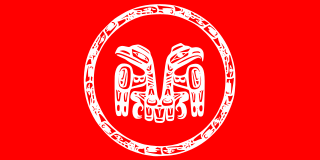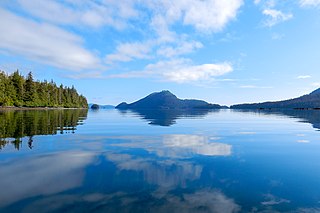
Haida are an indigenous group who have traditionally occupied Haida Gwaii, an archipelago just off the coast of British Columbia, Canada, for at least 12,500 years.

Haida Gwaii, formerly known as the Queen Charlotte Islands, is an archipelago located between 55–125 km (34–78 mi) off the northern Pacific coast of Canada. The islands are separated from the mainland to the east by the shallow Hecate Strait. Queen Charlotte Sound lies to the south, with Vancouver Island beyond. To the north, the disputed Dixon Entrance separates Haida Gwaii from the Alexander Archipelago in the U.S. state of Alaska.

Gwaii Haanas National Park Reserve, National Marine Conservation Area, and Haida Heritage Site, usually referred to simply as Gwaii Haanas, is located in southernmost Haida Gwaii, 130 kilometres off the mainland of British Columbia, Canada. Gwaii Haanas protects an archipelago of 138 islands, the largest being Moresby Island and the southernmost being Kunghit Island. "Gwaii Haanas" means "Islands of Beauty" in X̱aayda kíl, the language of the Haida people.

Skidegate is a Haida community in Haida Gwaii in British Columbia, Canada. It is on the southeast coast of Graham Island, the largest island in the archipelago, and is approximately 50 kilometres (31 mi) west of mainland British Columbia across Hecate Strait.

Daajing Giids, known as Queen Charlotte City from 1891–2022, is a village municipality in the Haida Gwaii archipelago in the province of British Columbia, Canada. It is located on the southern end of Graham Island at Skidegate Inlet and is a member municipality of the North Coast Regional District.

Moresby Island is a large island that forms part of the Haida Gwaii archipelago in British Columbia, Canada, located at 52°45′00″N131°50′00″W. It is separated by the narrow Skidegate Channel from the other principal island of the group to the north, Graham Island.

New Clew, also Clue, Kloo, Kliew, Klue, Clew Indian Reserve, is a locality and First Nations reserve of the Haida people, located on the north shore of Louise Island, which is located in Cumshewa Inlet on Haida Gwaii, formerly known as the Queen Charlotte Islands, of the North Coast of British Columbia, Canada.

Cumshewa is a former village of the Haida people located on the north flank of Cumshewa Inlet in the Haida Gwaii of the North Coast of British Columbia, Canada. It is named for Cumshewa, an important Haida chief during the era of the Maritime Fur Trade, as is Cumshewa Head, an important headland and point on the north side of the opening of Cumshewa Inlet, which pierces Moresby Island from the east and was the location of several historical Haida villages.
Cumshewa Inlet, also recorded or referred to in exploration logs as Cumchewas Harbour and Tooscondolth Sound, is a large inlet on the east coast of Moresby Island in the Haida Gwaii islands of the North Coast of British Columbia. The inlet was the site of various Haida villages, including Cumshewa, Tanu and Djí-gua. The name for the inlet was conferred in the days of the Maritime Fur Trade following a custom whereby captains named locations for the most important local chief, in this case Cumshewa, who figures in maritime fur trade vessel logs from 1787 onwards. In 1794 Cumshewa and his followers massacred the crew of the American trading vessel Resolution in Cumshewa Inlet.

Anthony Island is an island located in the southern part of Haida Gwaii, off the North Coast of British Columbia, Canada, to the west of Kunghit Island, the archipelago's southernmost. Anthony Island is noted for being the location of the ruins of SkungWai or SG̱ang Gwaay Llnaagay, commonly called Ninstints after the reigning mid-19th Century chief there. SG̱ang Gwaay Llnagaay was a major village of the Kunghit Haida people.

Skedans, also known variously as Koona, Q'una, Koona LLnaagay, K'uuna Llnagaay, Q!o'na Inaga'-I, Q:o'na, and Ḵ'uuna Llnagaay which are variants of its traditional name in the Haida language, is a village located at the head of Cumshewa Inlet in Haida Gwaii, North Coast of British Columbia, Canada. The name Skedans derived by the practice of captains of the maritime fur trade to name villages after their most prominent chiefs.

SG̱ang Gwaay Llnagaay, commonly known by its English name Ninstints, is a village site of the Haida people and part of the Gwaii Haanas National Park Reserve and Haida Heritage Site on Haida Gwaii on the North Coast of British Columbia, Canada.

Ḵung is a Haida village, located on the west side of Alexandra Narrows on Graham Island, the largest and northernmost island of Haida Gwaii alongside British Columbia, Canada. Alexandra Narrows, known on some old maps as Mazzaredo Sound, connects Naden Harbour and Virago Sound. An earlier village located at the current village site was named ‘Nightasis’ by the fur trader John Work, and records that in 1840 there were 15 houses with 280 residents.

Gwaii Haanas National Marine Conservation Area Reserve and Haida Heritage Site is a National Marine Conservation Area of Canada. It is located off the coast of the southernmost Haida Gwaii, 130 kilometres off the mainland of British Columbia. It is immediately adjacent to Gwaii Haanas National Park Reserve and Haida Heritage Site. The level of protection differs from that of the National Park Reserve, however, allowing sustainable use of some natural resources in the area. Gwaii Haanas National Marine Conservation Area Reserve, which covers 3,400 square kilometres, is "a primary feeding habitat" of the humpback whale protected by Canada's Species at Risk Act (SARA).

The Haida Heritage Centre is the premier cultural centre and museum of the Haida people. It is located in Skidegate, a community on Graham Island in Haida Gwaii off the Pacific coast of British Columbia, Canada. The centre is situated just south of the site of a historical village in Kay Llnagaay. The Centre was built and is managed by Gwaalagaa Naay, an economic development branch of the Skidegate Band Council, the owners of the site. It is one of the major aboriginal cultural tourism attractions in Haida Gwaii and has been described as "a place for the Haida voice to be heard." Educational programs are offered in partnership with School District 50 Haida Gwaii, the University of Northern British Columbia, and with the Haida Gwaii Higher Education Society.

Hlk'yah G̱awG̱a, also known as Windy Bay, is located on Athlii Gwaii in southern Haida Gwaii, British Columbia. The site was historically the location of a Haida village named Hlk'yah Llnagaay, meaning Peregrine Falcon Town in English. In the 1980s, Hlk'yah G̱awG̱a was the focus of a series of lawsuits and protests opposing clearcut logging on the island. These demonstrations were the impetus for the signing of the Gwaii Haanas Agreement of 1993 and the creation of the Gwaii Haanas National Park Reserve, National Marine Conservation Area Reserve, and Haida Heritage Site.
Kiusta located on Haida Gwaii is the oldest Northern Haida village: and the site of first recorded contact between the Haida and Europeans in 1774. Haida lived in this village for thousands of years, due to the sheltered nature of its location it was used for boats offloading, especially in rough waters. Kiusta is one of the oldest archeological sites of human use in British Columbia, and continues to be a site for cultural revitalisation.

Various Imperial and colonial actions against Haida Gwaii Authorities have been undertaken since the 19th century. The indigenous peoples of Haida Gwaii often reacted violently to European and American ships which trespassed in their waters and lands. From the 18th to 19th centuries, various skirmishes took place between Haida authorities and European and American merchantmen and warships. Canadian settlers did not arrive on Haida Gwaii islands until 1900, and many Canadian colonial police actions attempted to assault the Haida Gwaii authorities and citizens. The indigenous Haida population was decimated by diseases such as smallpox which were introduced accidentally by way of Fort Victoria. The presence of foreign diseases, to which the Haida had no immunity, along with some colonial hostility, meant that the numbers of Haida citizens was reduced from tens of thousands to 588 by 1915. This erosion of Haida cultural institutions was essential to open the way for subsequent British and Canadian incursions and jurisdictional claims.
Chaatl, also spelled Cha'atl, Tsaa'ahl, Tts’aa’ahl, and other variations, was a historic Haida village located on the shore of Chaatl Island, facing south across Buck Channel to the western side of northern Moresby Island, near the western end of Skidegate Channel, Haida Gwaii, British Columbia, Canada. Across Buck Channel from Chaatl was the long-abandoned village site of Niisii. There were close connections between Chaatl and the nearby village of Kaisun, about 10 km (6.2 mi) to the south in a straight line, or about 20 km (12 mi) by water.
















